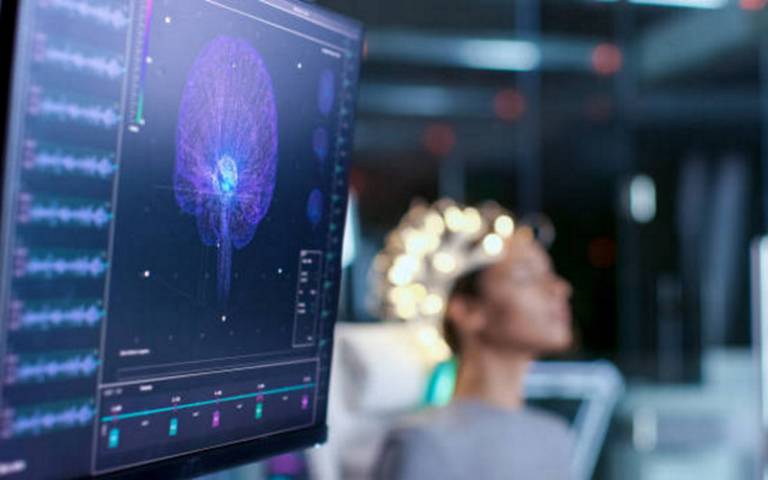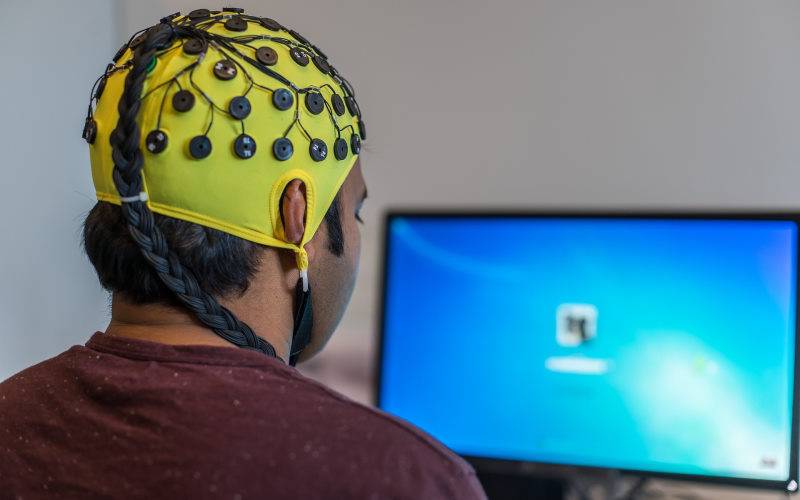Using an electroencephalogram to play a computer game
Vion, a 17-year-old sixth form student on work experience at Aspire CREATE, describes his experience of testing an electroencephalogram (EEG) to control a computer game.

1 August 2018
We used an electroencephalogram (EEG) to acquire the neural signals that would be processed by a Brain-Computer Interface (BCI) system to control a computer game. We had to write an additional piece of code to take the classified signals and translate it into left and right mouse-movements.
The control was nor perfect, but we were able to substitute the brain signals for a computer mouse with reasonable accuracy. The application of this research could be beneficial for patients who suffer from severe motor impairment. For example, for somebody with a spinal cord injury, a BCI system could produce commands directly from the brain, to control one or more external devices.
Overall, the performance was much better when the video game was manually controlled with a computer mouse, compared to when controlled with a BCI system. Nevertheless, within just a couple of days of practice with the video game, the performance had increased, with a general improvement trend throughout the sessions.
It remains unclear if the BCI system could perform the same tasks almost as effectively as a computer mouse. We concluded that although it would be feasible for a person with severe motor disabilities to play a video game without being able to move, they would still be incapable of playing completely independently.
Further research is required for a BCI system to completely substitute the full abilities of a functional computer mouse. This could, in turn, allow a person with a severe motor disability to freely play video games.
Experimental procedure and comments

For the neural activity recordings, we used an EEG, as it is non-invasive and has low risks.
The EEG system we used had 16 electrodes with embedded preamplifiers that were configured according to the international 10-20 electrode placement system.
The electrical brain signal was acquired with a sampling rate of 512Hz. The set-up procedure consisted of connecting a PC with an Ubuntu coding terminal to an amplifier which was connected to another preamplifier.
The next step was to position the EEG cap (from g-Tech) over the user's head, ensuring that the Cz placement was exactly half the nasion-inion distance, as well as the half-way between the ears, to centre the cap. After this, the conductive gel is applied to the electrodes protruding from the EEG cap, including the ground and reference electrodes. The difference in activity between these last two electrodes and the other electrodes allows the exclusion of external noise recorded by the EEG.
We checked the EEG signals on the software 'EEGview' to ensure that the 'impedance' and the signal quality were adequate to be able to start the BCI training.
Initially, we had to complete a few offline training sessions, where I had to passively focus on the sensation perceived when the arrows appeared before we could advance to the online training sessions, where I was able to control the movement of a bar. A BCI system must first learn about a user’s brain signals before it can use them to perform the output. It needed to learn my brain signals in response to which direction the arrow was pointing. As a result, during the online training sessions, I was able to practise controlling the movement of the arrow towards the chosen direction.
After moving the arrow to the desired side of the screen at least 70% of the time, I was able to move on to a real game ('Jardinains 2'). The aim is to keep a ball on the screen by moving a little platform at the bottom of the screen horizontally from left to right. This would usually be accomplished by manually moving a computer mouse from left to right.
Playing the game using a BCI system was achieved by sending a signal from the EEG laptop to the 'Adafruit Feather 32u4 Bluefruit LE' (an all-in-one Arduino-compatible - Bluetooth - Low Energy development board with built-in USB and battery charging).
The connection of both PCs (the specific Ubuntu, with Linux, EEG laptop and the Windows laptop with the video game) was achieved by additional code written by Professor Tom Carlson. This sent the information from the EEG laptop to the feather with was connected via Bluetooth to the video game computer as a Bluetooth mouse.
As a result, the EEG laptop was able to read my brain signals and then translate them, so that the cursor on the Windows laptop could be controlled.
It was an unforgettable, fantastic, eye-opening, and fun educational experience. I wish that I could return with more knowledge to continue my EEG-based BCI research, with innovative techniques and new technologies.
Vion Vimalan
About Vion
I applied for a Nuffield Research Placement between Year 12 and 13 because I have a passion for the sciences and love to learn and use my analytical brain to solve problems methodically.
I am currently completing A-Level courses in Biology, Chemistry, Maths and Psychology, because I enjoy the challenge of solving new problems.
My interests lie in the medical/healthcare field, so I would like to take a degree that enables me to apply my scientific knowledge to improve lives, either by medical diagnosis or clinical lab-based treatment/prevention development, to improve peoples' quality of life.
My ultimate goal is to apply what I have learned to the real world, where I will be able to make a difference and improve society for the better.
 Close
Close

